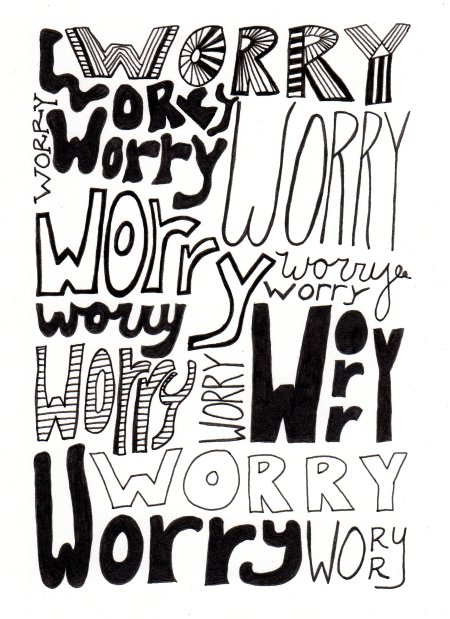Every child, from every culture from every corner of the world, knows about the boogeyman. It’s the amorphous, invisible man (or woman) who invokes fears and nightmares. The boggeyman is what wakes them up in the middle of the night, crying, seeking safety and comfort from their parents. Most children eventually outgrow this phase of their childhood; the mysterious creature that stirred up so much dread (and was a construct of his/her imagination in the first place) no longer has the same hold on them.
You and I may outgrow the nightmares of our childhood. But I submit the adult version simply takes on a different form and happens in the light of day with our eyes wide open.
Need proof? Grab a pen and piece of paper.
List three-five things about which you are currently worrying.
I bet you were able to do that exercise in less than 60-seconds! Was I correct?
What’s on your list? Are you worried about the security of your job or the viability of your business; are you frustrated with your current job and worry about how and when to make a change; are you worried about money, stressed out about having more obligations than you have resources for; has financial stress caused a strain in your relationship with your mate so that you are now worried about the strength of that relationship; are you contending with aging parents in declining health; and has all of this filtered down to your own health because you aren’t eating properly, exercising or just plum relaxing. Oh, and I haven’t even mentioned children if you are a parent. Is what is keeping you up at night – literally and/or figuratively – also causing you to question if your are being the best possible parent?
Unlike the boogeyman of your childhood, which isn’t real and is based largely on unfounded fears. The majority of things that cause you anxiety as an adult are very, very real. So, I’m not going to be Pollyannaish and say, “don’t worry.” Instead, I am going to offer a strategy to help you turn the bad side of worry into a positive force – one that could reveal creative ways for facing some of the incredible challenges you may be confronting. The benefit of this approach is that it is timeless and applicable regardless of the source of your worry.
This tactic for managing your worries is based on an approach businesses and researchers use to refine the products and services they offer.
But before sharing this strategy, let’s look at an example of the good side of worry – the side that’s gets very little attention, yet can motivate you to success, allow you to foresee potential dangers, and proactively create solutions to problems. As Dr. Martin Rossman said in a Huffington Post piece – ‘Good Worry’ – How Worrying Well Can Help You Manage Stress – “worry is an adaptive survival function: we use our imaginations to anticipate potential dangers, then develop ways to avoid them. Worry helps keep our loved ones and ourselves alive.” Dr. Rossman’s statement reminds me of what a dive master once told me whilst on scuba diving trip in Tortola, BVI: “The day you get on a boat and are not afraid is the day you shouldn’t go scuba diving.” Her point to me was that “fear, jitters, worry,” are good – they will prompt me to do one last check of my scuba gear to confirm everything is working properly.
‘Good’ worry can ensure your safety and contribute to your success.
But ‘good’ worry isn’t the type of worry that typically consumes your waking hours. That honor goes to ‘bad’ worry – the kind where you envision the worst possible outcome and fret about what you don’t want to happen. I call ‘bad’ worry the grown-ups boogeyman.
Unchecked ‘good’ worry can easily devolve into ‘bad’ worry, draining you of all motivation, prompting you to see everything as a danger, and cutting off all creative thinking.
Businesses and researchers use something called the “so what?” factor to help others see the problem they are solving more clearly. It is an exercise that forces them to drill down their message to what matters most to their ideal client/constituent.
Here’s where a modified version of the “so what?” factor can be a handy tool for managing worry and the stress it causes. When you are worried about a matter and you’ve crossed the line from ‘good’ to ‘bad’ worry, ask yourself, “Why does this worry me?” To your answer, ask yourself again, “Why does this worry me?” Ask the question 2-3 more times or until you have exhausted all possible answers/outcomes. Once you reach this point – aka you’ve identified the worst fear you can envision; the outcome you don’t want to happen, etc., ask yourself, “Do I possess any control over this outcome?” If so, reclaim your power and put a plan (or two) in place to avert the outcome you wish to avoid. If you can’t control the outcome, reclaim your power by redirecting your focus to what you can control and plan around those elements.
‘Bad’ worry is often accompanied by a paralysis of action, faulty vision and a loss of power. The ultimate benefit of employing the strategy I just shared is that you can see more clearly, and clarity always helps you take directed, positive-centered action. And in case you missed it, I just used the “so what?” factor!
P.P.S. We are launching our free Monthly Q&A Call next month – Monday, April 16th at 8pm. We’ll address common, as well as not so common, questions
about everything that affects your money and how money affects everything in your life. I can’t wait to hear your questions! Click here to get on the call list and to get the dial-in details.





